What are Microgreens?
-

Microgreens are essentially 'baby versions' of grain, herb, or vegetable greens cultivated in a growing medium and harvested within 2-3 weeks of planting– once the plant's first true leaves have emerged.
Despite their small size, Microgreens pack a nutritional punch, often containing 4 to 6 times higher nutrient levels than into their tiny leaves than more mature greens. This makes them a good addition to any diet.
-

Since their introduction to the Californian restaurant scene in the 1980s, microgreens have steadily gained popularity on cooking shows and in high-end restaurants. These diminutive superfoods can now be found on the shelves of many grocery stores and on windowsills in US and Europe.
The most commonly seen microgreens are radish, sunflower, and broccoli, but literally almost any vegetable, herb, legume, or grain can be grown as a microgreen.

How Do They Compare to Adults Greens?
Microgreens are absolutely more nutrient-dense than their adult greens counterparts. An American chemical study looked at nutrient levels of 25 different microgreens and compared them to full-sized leafy vegetables and herbs. Nutrient levels in different microgreens varied, but they always had higher levels per gram of vitamin C, vitamin E, vitamin A than mature crops.

Why Microgreens?
Higher Levels of Key Nutrients
Microgreens are superfoods—nutrient-rich plants that contain larger amounts of essential vitamins, minerals, antioxidants, phytonutrients and enzymes than their more mature counterparts. Scientists see Microgreens as a functional food, which means that they can provide key nutrients in a practical way:
Why Microgreens?
Health Benefits of Microgreens
The key nutrients and enzymes in Microgreens are beneficial to your health. By adding Microgreens to your diet, it can help with preventing a range of diseases, managing weight and boosting both mental and physical health and well-being.

Why Microgreens?
Flavorful & Colorful
Not only are the nutrients highly concentrated in microgreens, but so are the concentrations of flavors and colors. These factors are loosely correlated, so an easy rule of thumb for picking which greens to eat is to choose the most colorful ones. This remains the case with microgreens! The smaller leaf size and high nutrient concentration make microgreens particularly flavorful and colorful. This is why so many chefs like to use them as garnishes.
"An Ounce of Prevention is Worth a Pound of Cure"
When it comes to preventing disease, nothing is more powerful than natural foods such as microgreens!
In fact, a group of scientists at the University of Maryland Agriculture & Natural Resources Department and the U.S. Department of Agriculture (USDA) found that living microgreens have up to 40 times more nutrients than their mature counterparts. These functional foods can help in the prevention and treatment of degenerative diseases such as Alzheimer’s, Parkinson’s, Heart Disease and Arthritis, with Cancer being at the forefront of current research studies. In addition, their high nutrient content can help lower blood pressure, lower cholesterol, improve digestion, strengthen bones and teeth, improve eyesight, and balance blood sugar!




